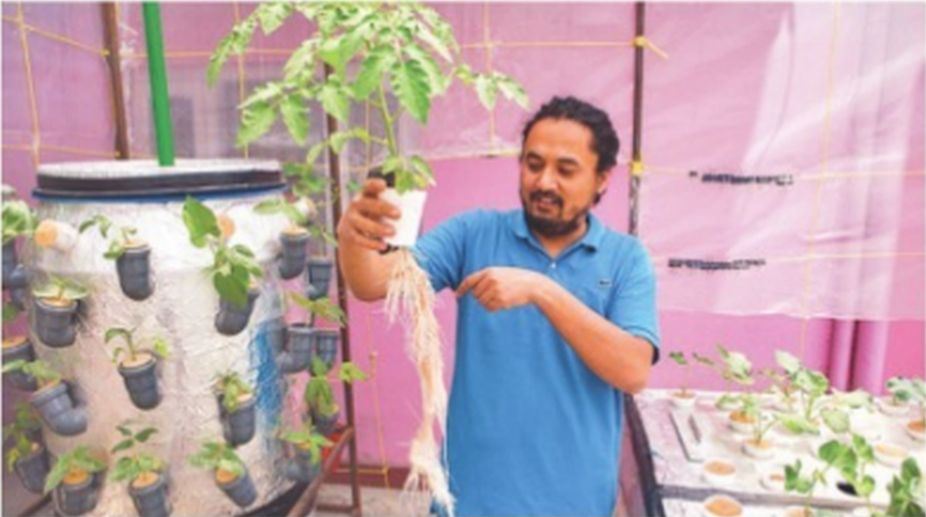NASA head Nelson says China hiding military presence in space
"I think that we just better not let down our guard," Nelson added.

PHOTO: SNS
Strange things are happening on the rooftop of a family house in Kathmandu’s Kalanki. Lush green plants are sprouting out of plastic barrels wrapped in aluminium foil. The sight of the plants’ dark green hues in contrast to the metallic sheen from the aluminium foil is both beautiful and alien. Could this be the future of farming?
“We are attempting to build an automated plant growing machine,” says Caesar Rana, co-creator of the experiment. “The machine will provide the plants with everything they need to thrive so that farmers only have to worry about sowing seeds and reaping harvests.” In essence, Rana and his partner Prakash Dahal want to create a system that will automatically handle much of backbreaking farm work like watering, fertilising, weeding, tilling and even pest control. A tall order by any standard but Rana and Dahal are determined to realise their vision of eliminating the drudgery from agriculture.
Their machine is based on a radical new idea called aeroponics, which is the same technology being mooted by Nasa for future astronauts during the potential colonisation of Mars. Instead of soil and traditional fertilisers, aeroponics uses a fine mist of carefully prepared nutrients to sustain and nurture plants using no soil and little water.
Advertisement
“Our system uses one percent of the water necessary in traditional farming and only 10 percent of the water needed for comparable hydroponics systems,” Dahal says, adding, “Our plants also grow 30 percent faster and are more disease resistant than those grown in hydroponics or soil.” Hydroponics is a method of growing plants that uses water and soil-less media like coco peat or expanded clay pebbles.
It is nothing short of incredible that two professors teaching finance and entrepreneurship were able to create what they did with no prior experience in agriculture, biology, chemistry or engineering. Their machine, which went online on Nepali New Year’s day, can grow 380 plants on less than 40 litres of water a week and runs on a fraction of the power requirements of an average 14 inch laptop. “We have learnt more in the last few months than we have in the many years before that,” Dahal reminisces. “From plant nutrition and mist generation to more practical concerns like drilling large holes into the sides of plastic drums, the range of topics we have had to research was mind boggling,” he adds.
The creators of the aeroponics system admittedly imported only the mist nozzles and the high pressure pump from a supplier in China and put together the remainder of the machine using only materials that are readily available in Nepal. “We wanted our system to be as affordable as possible so that more people in Nepal could start using it. As such, we tried to use locally available materials and components for the construction of the machine as much as it was practical,” they explain.
When asked if their machinegrown produce can be called organic, Rana replies, “Yes, we are 100 percent organic because in addition to only using organic seeds and fertilisers, we also source the highest quality nutrients to make our nutrient solution. The nutrients in our solutions are essentially simple inorganic salts and chelates that can even be ingested by humans harmlessly at the concentrations that we employ.” In addition, growing in a perfect blend of essential nutrients, the plants in aeroponic systems are naturally more resistant to diseases and pests. “Due to the absence of soil, the life cycles of many pests and parasites cannot be complete in an aeroponic system, further reducing the need for any type of pesticides or chemicals,” he adds.
Dahal believes that there are several possible ways for them to grow as a business once their grand experiment comes to an end. “The obvious way to grow would be to establish big farms to cater to the fresh vegetables demand in Kathmandu. But we also want to take this technology to growers at the household levels who can set up something similar to our Kalanki experiment on their rooftops or kitchen gardens. Home gardeners will be able to produce nearly all the vegetables they will need using a system that is slightly smaller than our experiment.” Now, once saplings are inserted into the duo’s aeroponic system, home growers only need to spend a few minutes to measure and adjust the pH levels and the concentration in their nutrient solution once every few days to ensure a rich harvest.
Rana says, “In addition to saving you time and work, the system will also save you money because you use a fraction of the water compared to a traditional garden and the cost of the nutrients will be lower than the costs of the fertilisers and soil conditioners necessary for soil-based farming.”
Aeroponics systems are also more suitable for rooftop installations because of their comparatively lighter weight. “Our experimental system weighs a total of 250 kg, including the weight of the greenhouse and the nutrient solution. A comparable hydroponics system would weigh nearly two tonnes and a soil based method would be even heavier,” they explain.
Rana maintains that the benefits of aeroponics over other methods of farming are so significant that many experts across the world are calling it the future of agriculture. “It eliminates tedious chores, increases productivity by up to 20 times, reduces the need for harmful pesticides and demands much less water. To put that in perspective, a 10-ropani (about 5,000 square metres) aeroponic greenhouse with extended lighting and climate control will have the same productivity as 200 ropanies of fertile and irrigated fields,” he says, adding, “If we are able to develop this technology in Nepal, we will be in the forefront of agricultural innovation and productivity by global standards.”
The kathmandu post/ann
Advertisement